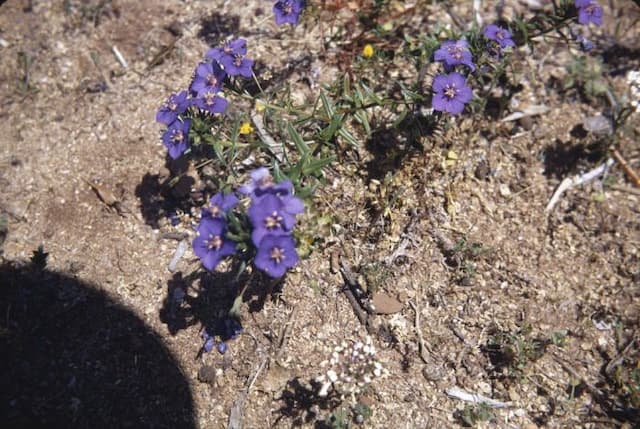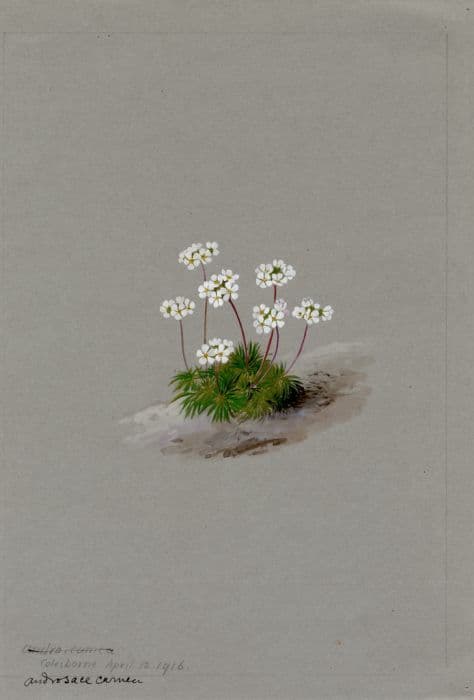Auricula Primula auricula 'Nymph' (Au/d)

ABOUT
Primula auricula 'Nymph' is characterized by its beautiful, ornate flowers and lush foliage. The flowers are quite striking, with a rich, velvety texture and a color palette that showcases shades of deep yellow to gold, often with a distinct, contrasting center or "eye" that can be a darker hue or a different color entirely. The petals may have a rounded or slightly pointed shape, radiating out from the center to form a circular pattern. The leaves of Primula auricula 'Nymph' add to the plant's visual appeal, with a rosette formation at the base. They are typically a bright green, sometimes with a hint of a powdery coating that gives them a slightly greyish tint. The leaves can be somewhat fleshy and have smooth edges that may curl gently, which adds to the ornamental value of the plant. Overall, the aesthetics of Primula auricula 'Nymph' make it a popular choice for gardeners and plant enthusiasts who wish to add a splash of color and texture to their collection, often grown for decorative purposes in gardens, borders, or as part of a rockery ensemble.
About this plant
 Names
NamesFamily
Primulaceae
Synonyms
Bear's Ear, Mountain Cowslip, Auricula
Common names
Primula auricula 'Nymph' (Au/d).
 Toxicity
ToxicityTo humans
The common name for Primula auricula 'Nymph' (Au/d) is Bear's Ear. Bear's Ear is generally considered non-toxic to humans. However, some people may experience mild discomfort or allergic reactions when touching or handling the plant due to the presence of primin, a skin irritant found in the family Primulaceae. Ingesting the plant is not advised since it could potentially cause mild stomach upset if consumed in large quantities. There are no severe poisoning symptoms commonly associated with the ingestion of Bear's Ear in humans.
To pets
The common name for Primula auricula 'Nymph' (Au/d) is Bear's Ear. Bear's Ear is not commonly listed as a toxic plant to pets such as dogs and cats. However, as with humans, some animals may have sensitive reactions to the plant if they ingest it, potentially resulting in mild gastrointestinal upset, such as vomiting or diarrhea. Always monitor your pet's reaction to new plants and consult with a veterinarian if you observe any signs of distress after ingestion.
 Characteristics
CharacteristicsLife cycle
Perennials
Foliage type
Evergreen
Color of leaves
Green
Flower color
Yellow
Height
6 inches (15 cm)
Spread
6 inches (15 cm)
Plant type
Herb
Hardiness zones
5
Native area
Europe
Benefits
 General Benefits
General Benefits- Aesthetic Appeal: Primula auricula 'Nymph', also known as Auricula, adds color and beauty to gardens with its unique and vibrant flowers.
- Easy to Grow: Auriculas are generally easy to care for and can thrive in a range of garden conditions.
- Long Blooming Season: They have a relatively long blooming period, which ensures that gardens have color for an extended time.
- Attracts Pollinators: The flowers attract bees and butterflies, which are beneficial for the pollination of plants and the overall health of the garden.
- Versatility in Garden Design: Auriculas can be used in various garden designs including rockeries, containers, and borders.
- Drought Tolerance: Once established, some varieties of Auriculas are drought-tolerant, making them suitable for gardens in drier climates.
- Compact Size: Their compact growth habit makes them ideal for small spaces or as part of a mixed planting in larger beds.
 Medical Properties
Medical PropertiesThis plant is not used for medical purposes.
 Air-purifying Qualities
Air-purifying QualitiesThis plant is not specifically known for air purifying qualities.
 Other Uses
Other Uses- Primula auricula, commonly known as Bear's Ear, can be used in botanical art and illustration for its vivid colors and unique shape, providing inspiration for artists and illustrators.
- The vibrant petals of Bear's Ear can be used to create natural dyes for textiles, offering a range of yellow to green hues depending on the mordant used.
- In perfumery, Bear's Ear occasionally contributes its light, fresh floral scent to fragrance blends, although it is not a common ingredient.
- Because of its attractive foliage, Bear's Ear can be used as a living mulch in gardens, providing a ground cover that helps retain soil moisture and suppress weeds.
- Fine dining restaurants may use the edible flowers of Bear's Ear as a decorative garnish for desserts and salads, adding a splash of color to dishes.
- The plant's ability to tolerate cold temperatures makes Bear's Ear a candidate for creating living refrigerated displays in floral arrangements or for special botanical showcases.
- Enthusiasts of miniature and fairy gardens use Bear's Ear due to its small size and ornamental appearance, adding charm to these whimsical creations.
- Bear's Ear can serve as a natural indicator of environmental health, as it may only thrive in certain conditions, signaling the quality of the local ecosystem.
- Floriculture education programs often include Bear's Ear to teach students about alpine plant care and propagation techniques.
- During nature-themed festivals, Bear's Ear is used in plant competitions and showcases due to its distinct appearance and variety of colors.
Interesting Facts
 Feng Shui
Feng ShuiAuricula, also known as Bear's Ear, according to Feng Shui can bring positive energy into the home when placed in the east sector for health or southeast for wealth, as their lush blooms are thought to symbolize growth and renewal.
 Zodiac Sign Compitability
Zodiac Sign CompitabilityThe Auricula is not used in astrology practice.
 Plant Symbolism
Plant Symbolism- Precious Beauty: The Primula auricula 'Nymph', commonly known as Auricula, is often associated with delicate and precious beauty due to its ornate appearance and bright, elegant colors.
- Pride: In the language of flowers, Auriculas can symbolize pride, reflecting the proud way in which they display their blooms.
- Patience: The Auricula is a perennial plant that requires patience to cultivate and bloom, hence it can represent the virtue of patience.
- Courage and Originality: The varied and unique patterns of Auriculas' flowers can be seen as a symbol of individual courage and originality.
- Survival in adversity: Auriculas are known for their resilience and ability to thrive in harsh conditions, symbolizing the strength to persevere through adversity.
 Water
WaterAuriculas, including 'Nymph', prefer evenly moist soil and should not be allowed to dry out completely; however, they also do not like to be waterlogged. Water the plant whenever the top inch of the soil feels dry, which could be about once a week, depending on environmental conditions. Use a watering can to gently water the soil, not the foliage, with about 8-16 ounces of water per plant each time. During the active growing season in spring and fall, they may need more frequent watering, while in winter, when the plant is dormant, watering should be reduced.
 Light
LightAuriculas like 'Nymph' thrive best in bright, indirect light. They can also tolerate morning sun, but they should be protected from strong, direct afternoon sunlight. A north-facing windowsill or a spot that receives filtered light is ideal for these plants to prevent leaf scorch and ensure vibrant flower colors.
 Temperature
TemperatureAuriculas such as 'Nymph' prefer cooler temperatures and can tolerate a range from 40 to 70 degrees Fahrenheit. They do not do well in prolonged temperatures above 80 degrees Fahrenheit or below freezing. The ideal temperature for promoting flowering and healthy growth is between 50 and 60 degrees Fahrenheit.
 Pruning
PruningAuriculas, such as 'Nymph', benefit from pruning to remove dead or fading flowers and to encourage bushier growth. Prune after blooming by snipping off spent flower stalks at their base. Occasional removal of dead leaves is also recommended to keep the plant looking tidy and to prevent potential disease issues.
 Cleaning
CleaningAs needed
 Soil
SoilAuricula Primrose, commonly known as Primula auricula 'Nymph', thrives in well-draining, slightly alkaline soil with a pH range of 6.0 to 7.5. A mix comprising one part loam, one part coarse sand or perlite, and one part leaf mold or well-rotted compost provides the ideal growing medium.
 Repotting
RepottingAuricula Primroses should be repotted annually to replenish the soil and accommodate growth. It is best to repot them in the spring after flowering, taking care not to damage the sensitive roots during the process.
 Humidity & Misting
Humidity & MistingAuricula Primrose prefers a moderately humid environment. Aim to maintain humidity levels of about 50-60%, similar to that of its natural alpine habitat, to promote healthy growth and flowering.
 Suitable locations
Suitable locationsIndoor
Keep Auricula Primrose in bright, indirect light with good airflow indoors.
Outdoor
Place Auricula Primrose in partial shade, sheltered from harsh weather.
Hardiness zone
4-8 USDA
 Life cycle
Life cycleThe life of the Auricula, Primula auricula 'Nymph', begins with seed germination, typically in spring or autumn under favorable conditions of moisture and temperature. As the seedlings emerge, they grow into a rosette of leaves, entering their vegetative stage. During this time, they establish a strong root system and foliage. The next stage is the flowering phase, where the plant produces its distinctive, colorful flowers, typically in early spring. After pollination, often by insects, the flowers develop into seed pods if conditions are right, completing the reproductive cycle. Finally, the plant goes dormant during the winter, with some foliage usually remaining evergreen, and the cycle begins anew with the next growing season.
 Propogation
PropogationPropogation time
Spring to Summer
The most popular method for propagating the Primula auricula 'Nymph', commonly known as Auricula Primrose, is by division. This is typically done in late summer or early fall, after the blooming period has ended. To propagate by division, carefully dig up the plant and gently separate the crowns, ensuring that each section has a portion of the root system attached. The divisions should then be replanted in well-draining soil at the same depth they were growing previously. Water the new plants thoroughly to help establish them. It is critical to maintain consistent moisture without waterlogging the soil, as Auricula Primrose prefers evenly moist conditions.









